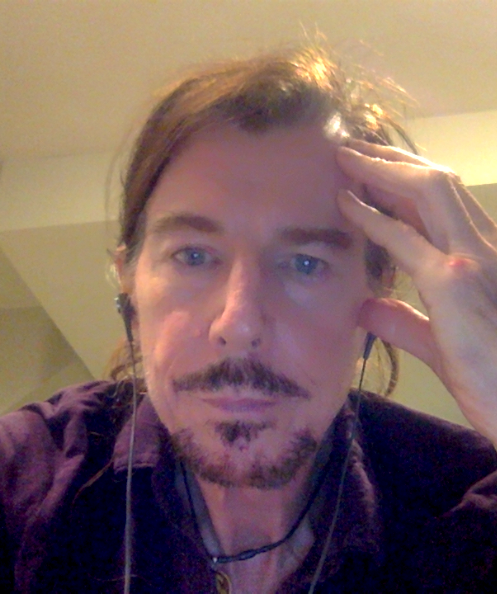 Last spring I wrote about Bill Buxton: Last spring I wrote about Bill Buxton:
Many years ago, when e-mail and Internet access were just becoming the norm in business, I met a guy named Bill Buxton, who was then with Alias Research. His passion was trying to make virtual ‘presence’ imitate, as much as possible, physical ‘presence’, to get the technology to adapt to our preferred information behaviours, instead of the other way around.
Bill’s mantra was:
Ultimately, we are deluding ourselves if we think that the products that we design are the “things” that we sell, rather than the individual, social and cultural experience that they engender, and the value and impact that they have. Design that ignores this is not worthy of the name.
To that end, he had computer screens around a circular table in his office, each showing the head and shoulders, and the computer desktop, of one his meeting participants, so that virtual meetings were as analogous as possible to ‘real’ meetings. He had another screen above his office door with a picture of a door on it, that he could virtually ‘open’ or ‘close’ to signify whether he was, or was not, available for impromptu e-consultations and e-conversations.
It was a little hokey, but Bill was (and still is, in his new work) on the right track.
Since then, Bill has moved forward with his work on the Customer Experience and written a book called Sketching User Experiences. The concept of ‘sketching’ is summarized in the graphic above. It is a “low-fidelity representation” of the customer experience that is detailed enough to provide context for how the customer lives/works/uses your product, but short enough that it doesn’t consume inordinate time to do so. The video (1:26:00 in length) explaining this in detail is here. He’s very entertaining, though the technical quality of the video is not great, and the first half is more valuable than the last half, IMO.
The ceramics teacher announced on opening day that he was dividing the class into two groups. All those on the left side of the studio, he said, would be graded solely on the quantity of work they produced, all those on the right solely on its quality. His procedure was simple: on the final day of class he would bring in his bathroom scales and weigh the work of the “quantity” group: fifty pound of pots rated an “A”, forty pounds a “B”, and so on. Those being graded on “quality”, however, needed to produce only one pot -albeit a perfect one – to get an “A”. Well, came grading time and a curious fact emerged: the works of highest quality were all produced by the group being graded for quantity. It seems that while the “quantity” group was busily churning out piles of work – and learning from their mistakes – the “quality” group had sat theorizing about perfection, and in the end had little more to show for their efforts than grandiose theories and a pile of dead clay.
This approach seems to work well for technology companies (hardware and software producers) but suppose your ‘product’ is, say, research reports, or improved health outcomes for your community? Can you ‘sketch’ new product design ideas using Buxton’s techniques? I think you can. And I think that’s where the idea of customer anthropology comes in. This anthropology is one of the techniques you use to research unmet customer needs. The transcription of the customer observations and interviews is a kind of “sketch” of your customers, and the needs that your enterprise might fill. But this isn’t what Buxton is getting at when he talks about sketching — he’s referring to the process of ideation to address those needs. In my new job, we’re starting to use customer anthropology to get a deeper understanding of our customers. We’ve identified about 15 distinct customer ‘segments’ with clearly different needs for the five types of research ‘products’ we offer:
As regular readers know, I generally tend to believe that things are the way they are for a reason, and before I propose changing things I want to make sure I understand those reasons. So my hypothesis is that the current design of these products is pretty good. But my instincts tell me that, like most products out there, the design could be much better. So I’m going to try to develop “sketches” of possible new designs for our five types of products, that draw on understanding how the current design has evolved, and on the results of our customer anthropology into what our customers want and need that they are not currently getting. I’d love to get Bill Buxton, a fellow Torontonian, involved in the process, to see how his technique translates to non-technology product design. I suspect I may have to ‘hire’ a sketch artist, though I’m certainly going to scour our organization to see if we have some hidden talent in this area. If this is successful, it could become the standard ‘front end’ to our ideation and innovation process– the means by which we respond in a consistent, disciplined and creative way to identified unmet customer needs and develop new and better products. What do you think? Is this a process that might work in your industry? Is there a sketch artist in your future? Category: The Innovation Process
|
Navigation
Collapsniks
Albert Bates (US)
Andrew Nikiforuk (CA)
Brutus (US)
Carolyn Baker (US)*
Catherine Ingram (US)
Chris Hedges (US)
Dahr Jamail (US)
Dean Spillane-Walker (US)*
Derrick Jensen (US)
Dougald & Paul (IE/SE)*
Erik Michaels (US)
Gail Tverberg (US)
Guy McPherson (US)
Honest Sorcerer
Janaia & Robin (US)*
Jem Bendell (UK)
Mari Werner
Michael Dowd (US)*
Nate Hagens (US)
Paul Heft (US)*
Post Carbon Inst. (US)
Resilience (US)
Richard Heinberg (US)
Robert Jensen (US)
Roy Scranton (US)
Sam Mitchell (US)
Tim Morgan (UK)
Tim Watkins (UK)
Umair Haque (UK)
William Rees (CA)
XrayMike (AU)
Radical Non-Duality
Tony Parsons
Jim Newman
Tim Cliss
Andreas Müller
Kenneth Madden
Emerson Lim
Nancy Neithercut
Rosemarijn Roes
Frank McCaughey
Clare Cherikoff
Ere Parek, Izzy Cloke, Zabi AmaniEssential Reading
Archive by Category
My Bio, Contact Info, Signature Posts
About the Author (2023)
My Circles
E-mail me
--- My Best 200 Posts, 2003-22 by category, from newest to oldest ---
Collapse Watch:
Hope — On the Balance of Probabilities
The Caste War for the Dregs
Recuperation, Accommodation, Resilience
How Do We Teach the Critical Skills
Collapse Not Apocalypse
Effective Activism
'Making Sense of the World' Reading List
Notes From the Rising Dark
What is Exponential Decay
Collapse: Slowly Then Suddenly
Slouching Towards Bethlehem
Making Sense of Who We Are
What Would Net-Zero Emissions Look Like?
Post Collapse with Michael Dowd (video)
Why Economic Collapse Will Precede Climate Collapse
Being Adaptable: A Reminder List
A Culture of Fear
What Will It Take?
A Future Without Us
Dean Walker Interview (video)
The Mushroom at the End of the World
What Would It Take To Live Sustainably?
The New Political Map (Poster)
Beyond Belief
Complexity and Collapse
Requiem for a Species
Civilization Disease
What a Desolated Earth Looks Like
If We Had a Better Story...
Giving Up on Environmentalism
The Hard Part is Finding People Who Care
Going Vegan
The Dark & Gathering Sameness of the World
The End of Philosophy
A Short History of Progress
The Boiling Frog
Our Culture / Ourselves:
A CoVid-19 Recap
What It Means to be Human
A Culture Built on Wrong Models
Understanding Conservatives
Our Unique Capacity for Hatred
Not Meant to Govern Each Other
The Humanist Trap
Credulous
Amazing What People Get Used To
My Reluctant Misanthropy
The Dawn of Everything
Species Shame
Why Misinformation Doesn't Work
The Lab-Leak Hypothesis
The Right to Die
CoVid-19: Go for Zero
Pollard's Laws
On Caste
The Process of Self-Organization
The Tragic Spread of Misinformation
A Better Way to Work
The Needs of the Moment
Ask Yourself This
What to Believe Now?
Rogue Primate
Conversation & Silence
The Language of Our Eyes
True Story
May I Ask a Question?
Cultural Acedia: When We Can No Longer Care
Useless Advice
Several Short Sentences About Learning
Why I Don't Want to Hear Your Story
A Harvest of Myths
The Qualities of a Great Story
The Trouble With Stories
A Model of Identity & Community
Not Ready to Do What's Needed
A Culture of Dependence
So What's Next
Ten Things to Do When You're Feeling Hopeless
No Use to the World Broken
Living in Another World
Does Language Restrict What We Can Think?
The Value of Conversation Manifesto Nobody Knows Anything
If I Only Had 37 Days
The Only Life We Know
A Long Way Down
No Noble Savages
Figments of Reality
Too Far Ahead
Learning From Nature
The Rogue Animal
How the World Really Works:
Making Sense of Scents
An Age of Wonder
The Truth About Ukraine
Navigating Complexity
The Supply Chain Problem
The Promise of Dialogue
Too Dumb to Take Care of Ourselves
Extinction Capitalism
Homeless
Republicans Slide Into Fascism
All the Things I Was Wrong About
Several Short Sentences About Sharks
How Change Happens
What's the Best Possible Outcome?
The Perpetual Growth Machine
We Make Zero
How Long We've Been Around (graphic)
If You Wanted to Sabotage the Elections
Collective Intelligence & Complexity
Ten Things I Wish I'd Learned Earlier
The Problem With Systems
Against Hope (Video)
The Admission of Necessary Ignorance
Several Short Sentences About Jellyfish
Loren Eiseley, in Verse
A Synopsis of 'Finding the Sweet Spot'
Learning from Indigenous Cultures
The Gift Economy
The Job of the Media
The Wal-Mart Dilemma
The Illusion of the Separate Self, and Free Will:
No Free Will, No Freedom
The Other Side of 'No Me'
This Body Takes Me For a Walk
The Only One Who Really Knew Me
No Free Will — Fightin' Words
The Paradox of the Self
A Radical Non-Duality FAQ
What We Think We Know
Bark Bark Bark Bark Bark Bark Bark
Healing From Ourselves
The Entanglement Hypothesis
Nothing Needs to Happen
Nothing to Say About This
What I Wanted to Believe
A Continuous Reassemblage of Meaning
No Choice But to Misbehave
What's Apparently Happening
A Different Kind of Animal
Happy Now?
This Creature
Did Early Humans Have Selves?
Nothing On Offer Here
Even Simpler and More Hopeless Than That
Glimpses
How Our Bodies Sense the World
Fragments
What Happens in Vagus
We Have No Choice
Never Comfortable in the Skin of Self
Letting Go of the Story of Me
All There Is, Is This
A Theory of No Mind
Creative Works:
Mindful Wanderings (Reflections) (Archive)
A Prayer to No One
Frogs' Hollow (Short Story)
We Do What We Do (Poem)
Negative Assertions (Poem)
Reminder (Short Story)
A Canadian Sorry (Satire)
Under No Illusions (Short Story)
The Ever-Stranger (Poem)
The Fortune Teller (Short Story)
Non-Duality Dude (Play)
Your Self: An Owner's Manual (Satire)
All the Things I Thought I Knew (Short Story)
On the Shoulders of Giants (Short Story)
Improv (Poem)
Calling the Cage Freedom (Short Story)
Rune (Poem)
Only This (Poem)
The Other Extinction (Short Story)
Invisible (Poem)
Disruption (Short Story)
A Thought-Less Experiment (Poem)
Speaking Grosbeak (Short Story)
The Only Way There (Short Story)
The Wild Man (Short Story)
Flywheel (Short Story)
The Opposite of Presence (Satire)
How to Make Love Last (Poem)
The Horses' Bodies (Poem)
Enough (Lament)
Distracted (Short Story)
Worse, Still (Poem)
Conjurer (Satire)
A Conversation (Short Story)
Farewell to Albion (Poem)
My Other Sites





I presume you know all about the Cognitive Edge approach of archetype sketches derived from the narratives in a community / system. I’m virtually certain that you do, as you’ve known avbout the Snowden et al approach for much longer than me. But just in case …I think that such sketches are very powerful ways to clarify and understand client (and constituent / stakeholder) issues.
I spent a lot of time with Bill Buxton interacting with Alias to improve the way we could sketch and interact with consumers in the FMCG products arena… designing new packaging… which you may have on your shelf at home! It is an incredible way of Design Fast Action at every stage through the process… making things tangible to make the right decisions at the right time… it saves an incredible amount of discussion time and opens up the possibility of increasing the search area for dialogue to find the more exciting (to consumers) answers!
useful link: http://channel9.msdn.com/media/ju_buxton.mp3